
The Harner Homestead, is a historic home outside Morgantown, Monongalia County, West Virginia.

Women's Christian Temperance Union Community Building, also known as the WCTU Building, is a historic building at 160 Fayette Street in Morgantown, Monongalia County, West Virginia. It was built in 1922 by the Woman's Christian Temperance Union, and is a detached, brick, four-story plus basement structure in the Classical Revival style. It features a smooth-cut stone cornice topped by a balustrade. The interior has a two-level basement that houses a large gymnasium. The building also houses office space, meeting rooms, private apartments, and recreational facilities.

Brown Building, also known as the Ream Building, is a historic commercial building located at Morgantown, Monongalia County, West Virginia. It was designed in 1898 by noted Morgantown architect Elmer F. Jacobs. It is a four-story eclectic style brick building. It has a flat roof and projecting cornice. It has a ball finial and parapet centered on the front facade. It features polychromatic brick detailing, accentuated bays and a triad of double-sash windows
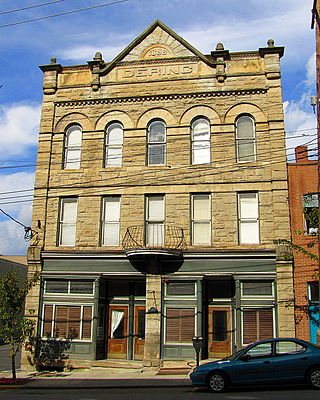
Dering Building is a historic commercial building located at Morgantown, Monongalia County, West Virginia. It was designed by noted Morgantown architect Elmer F. Jacobs and built in 1896. It is a three-story Romanesque Revival style brick building. It has a rectangular plan, a flat roof, separate store fronts, and recessed portico entrances. It features a pediment above the flat roof with a rising sun motif and the date of construction inscribed in the center.
Elmer F. Jacobs was a Morgantown, West Virginia-based architect.

Hackney House, also known as Hackney Place, is a historic home located at Morgantown, Monongalia County, West Virginia. The original section was built in 1892, and is a square, 2+1⁄2-story balloon frame structure with a Queen Anne style entrance porch. A two-story, square addition was added shortly after the original construction. It sits on a cut sandstone foundation.
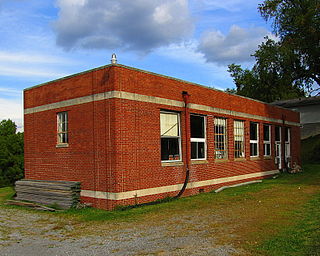
Second Ward Negro Elementary School, also known as the Second Ward Annex, is a historic school building located at Morgantown, Monongalia County, West Virginia. It was built in 1938–1939, and is a one-story, plus basement, T-shaped brick building in the Art Deco style. It sits on a sandstone foundation. Funds for the building's construction were provided by the Works Progress Administration. It functioned as a school for African American students and a community center until the end of segregation in 1954. The building reopened as a school annex and Instructional Materials Center in the 1960s, but ceased being used as a school in 1993.
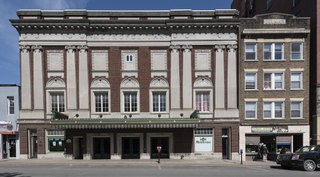
Metropolitan Theatre is a historic theater building located at Morgantown, Monongalia County, West Virginia. It opened July 24, 1924, two-and-a-half years after construction began, and consists of a single floor auditorium with balcony. The building measures 72 feet by 143 feet, and has two storefronts on the ground floor and a pool room in the basement. The front facade features fluted concrete Ionic order pilasters with egg-and-dart detail in the Classical Revival style. The theater continues to provide a home for the city's best live entertainment.

Kincaid and Arnett Feed and Flour Building is a historic warehouse building located at Morgantown, Monongalia County, West Virginia. It was built between 1904 and 1906, and is a three-story, vernacular brick warehouse located along the banks of the Monongahela River. It is trapezoid shaped and has a prominent concrete-block loading dock with overhead canopy. Kincaid and Arnett functioned as a prosperous wholesale and retail grain dealership and brokerage until they sold the property to Morgantown Feed and Flour Corporation in February 1921.
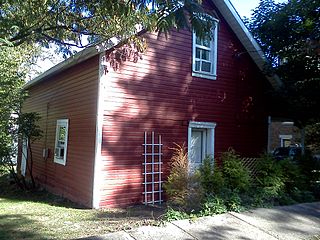
Kern's Fort, also known as Michael Kern's Cabin, is a historic home located at Morgantown, Monongalia County, West Virginia. It is a one-story log house built in 1772. It is built of chestnut logs and covered with wood clapboards. Attached to the rear is a 19th-century frame addition. It was built by Michael Kern, perhaps, the first permanent settler of what is now Morgantown. When Lord Dunmore's War started in 1774, Kern built a stockaded fort around his cabin.
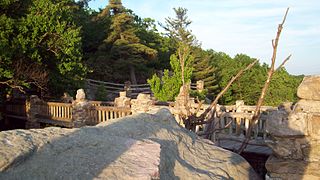
Camp Rhododendron, also known as Camp Rhododendron Recreational Historic District, is a historic Civilian Conservation Corps camp and national historic district located at Cooper's Rock State Forest near Morgantown, Monongalia County, West Virginia. The district includes seven contributing buildings, one contributing structure, and two contributing objects. It was constructed between 1936 and 1942, and includes a pumphouse, Robert Fechner Monument, information booth, three pavilions, an overlook / walkway, concession stand, fire warning sign, and trail chalet. They are built of hewn logs and sandstone and representative of the Depression-era Rustic style of architecture. Located nearby is the Cooper's Rock State Forest Superintendent's House and Garage, also built by the CCC.

Chancery Hill Historic District is a national historic district located at Morgantown, Monongalia County, West Virginia. The district originally included 109 contributing buildings and 1 contributing site, Oak Grove Cemetery. A boundary increase in 2001, added the already listed Alexander Wade House to the district. The district encompasses a residential area developed in the early-20th century on property that was once the farm of U.S. Senator Waitman T. Willey. It includes examples of popular architectural styles from that period including Queen Anne, American Foursquare, Colonial Revival, and Bungalow.

The Downtown Morgantown Historic District is a federally designated historic district in Morgantown, Monongalia County, West Virginia. The district, encompassing approximately 75 acres, has 122 contributing buildings and 2 contributing sites including commercial and public buildings, residences, and churches. The district has been listed on the National Register of Historic Places since May 2, 1996. Ten of the contributing buildings are listed separately on the National Register of Historic Places. Significant structures located within the historic district are the Monongalia County Courthouse, the Metropolitan Theater, and the Old Morgantown Post Office.

South Park Historic District is a national historic district located at Morgantown, Monongalia County, West Virginia. The district includes 501 contributing buildings and 5 contributing structures in a primarily residential area south of downtown Morgantown. The district is characterized by tightly packed dwellings on a hillside and represent a variety of post-Victorian architectural styles popular between 1900 and 1940. Notable buildings include the First Church of Christ, Scientist, Morgantown High School, Crestholm Pharmacy, and Bobbette's Confectionary.

Morgantown Wharf and Warehouse Historic District is a national historic district located at Morgantown, Monongalia County, West Virginia.

Kingwood Historic District is a national historic district located at Kingwood, Preston County, West Virginia. The district encompasses 103 contributing buildings in the central business district and surrounding residential areas of Kingwood. Most of the buildings are two story, frame and masonry buildings. Notable buildings include the Preston County Courthouse (1934), Kingwood National Bank Building (1908), C.M. Bishop House (1872), Preston Academy (1842), IOOF Lodge, Bank of Kingwood (1900), Bishop Block (1877), Presbyterian Church (1878), Methodist Church (1879), Wilson Building (1930), and Loar's Service Station (1927). Located in the district and listed separately is the James Clark McGrew House.

Henderson Hall Historic District is a National Register of Historic Places (NRHP)-listed historic district in Boaz, Wood County, West Virginia. The primary contributing property is Henderson Hall, a home in the Italianate style from the first half of the 19th century. Other residences at the site are a tenant house from the end of the 19th century, and "Woodhaven", the 1877 home of Henry Clay Henderson. Additional structures include a smokehouse, two corn cribs, a carriage barn that also served as a schoolhouse, a scale house used for storing agricultural equipment, and two barns. Also included within the district are the 19th-century Henderson family cemetery, a wall, a mounting block, and three mounds associated with the pre-Columbian Adena culture.

The Morgantown Historic District, also known as the Old Main Street Historic District, is a national historic district that is located in Caernarvon Township, Berks County, Pennsylvania.

Morgantown Historic District is a national historic district located near Marshall, Fauquier County, Virginia. It encompasses 7 contributing buildings and 2 contributing sites in the Reconstruction-era African-American rural village of Morgantown. The district contains four dwellings, the Mount Nebo Baptist Church (1902), an abandoned Morgantown School, a meat house, the ruins of an outbuilding, and a cemetery.

Morgantown Historic District is a national historic district located at Morgantown, Morgan County, Indiana. The district encompasses 34 contributing buildings in the central business district and surrounding residential sections of Morgantown. It developed between about 1840 and 1956, and includes notable examples of Greek Revival, Italianate, Late Gothic Revival, Queen Anne, and Bungalow/American Craftsman style architecture. Notable buildings include the Farmer's Cooperative Store / Blanche Crawford Building, First National Bank (1905), Obenshain Hotel (1860), Morgantown Town Hall (1900), Griffitt-Murphy House and Livery Bank (1895), Parkhurst House (1865), Redman's Lodge (1908), Wisby Hotel (1918), Telephone Exchange (1906), and Morgantown Methodist Episcopal Church complex (1923).






















